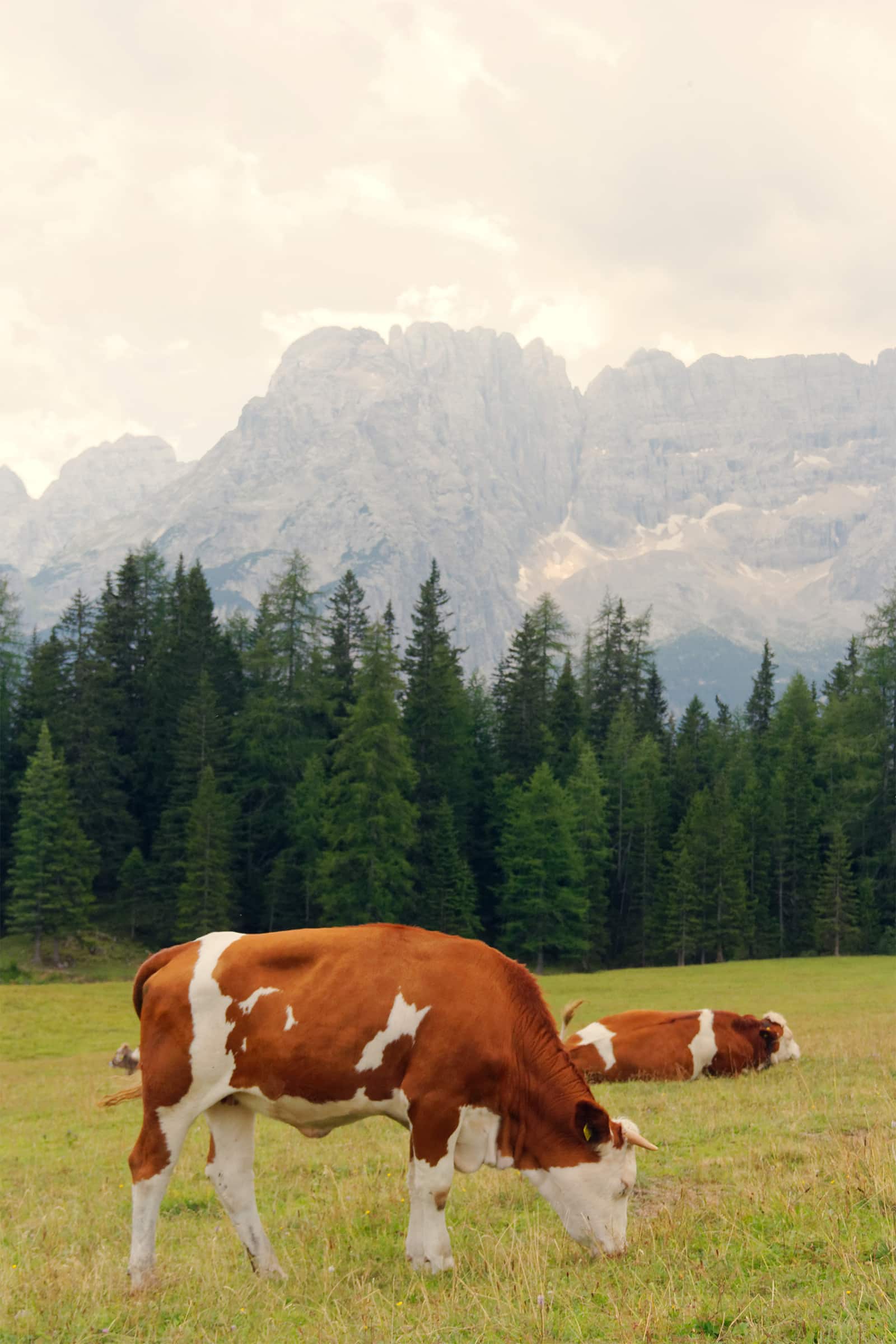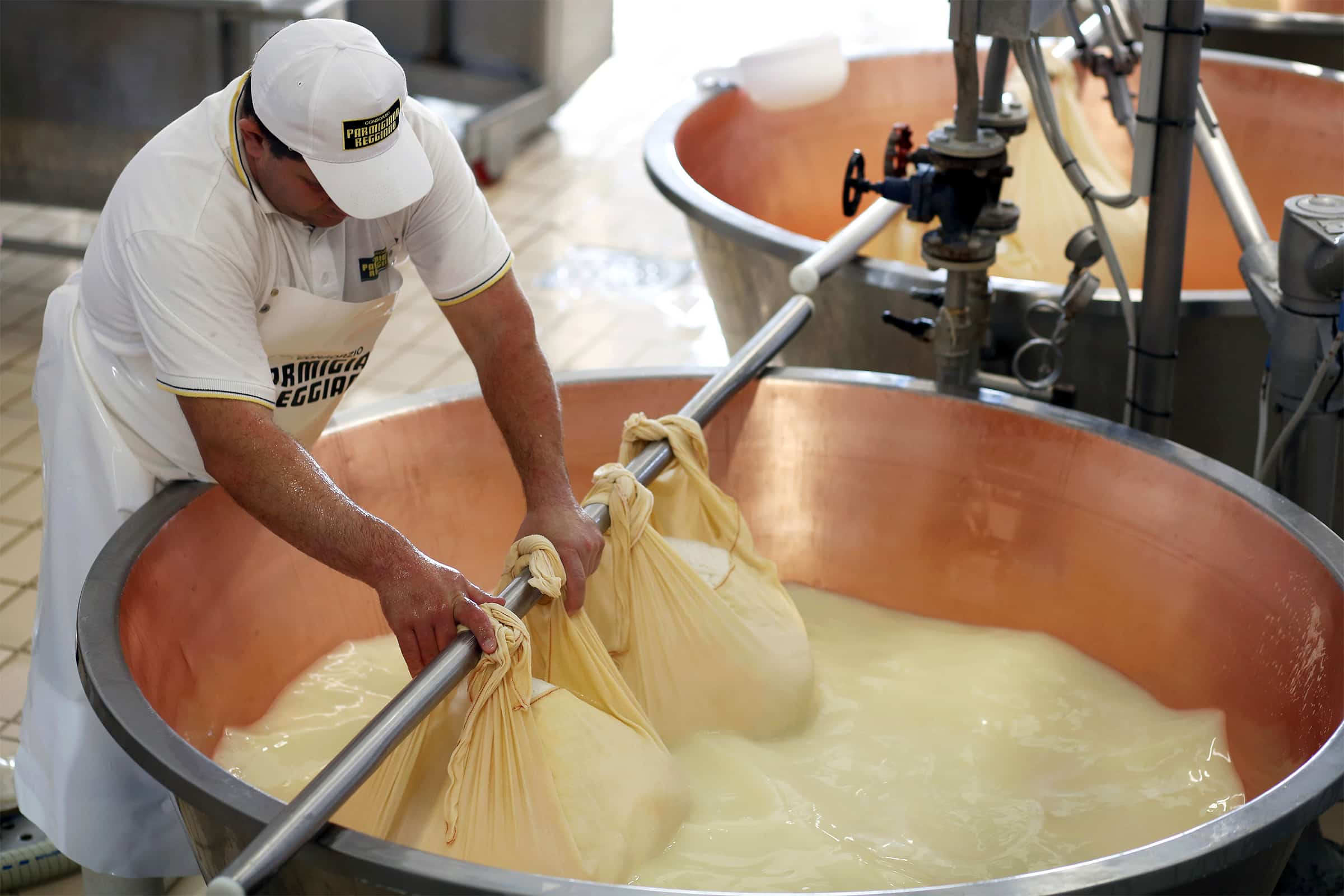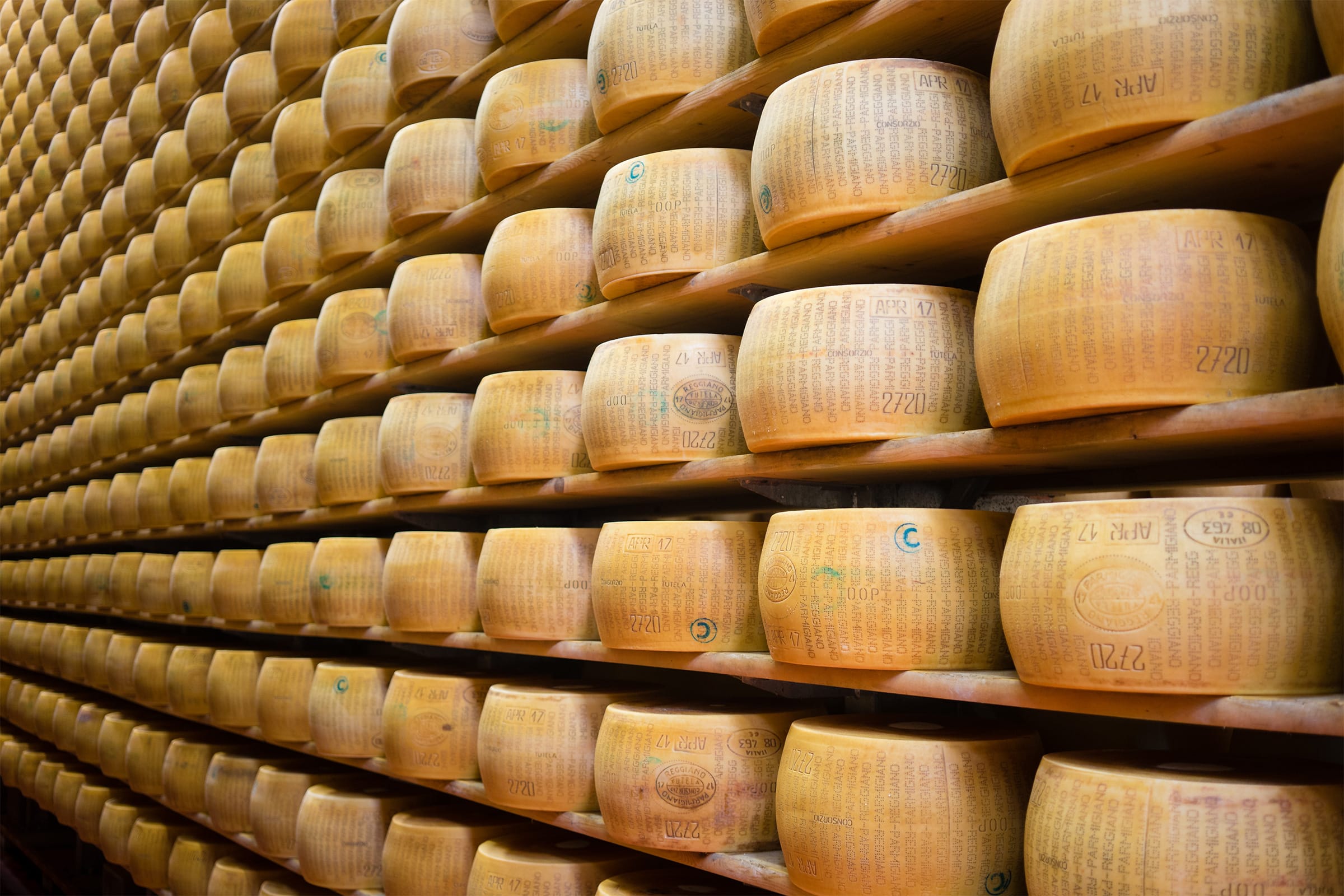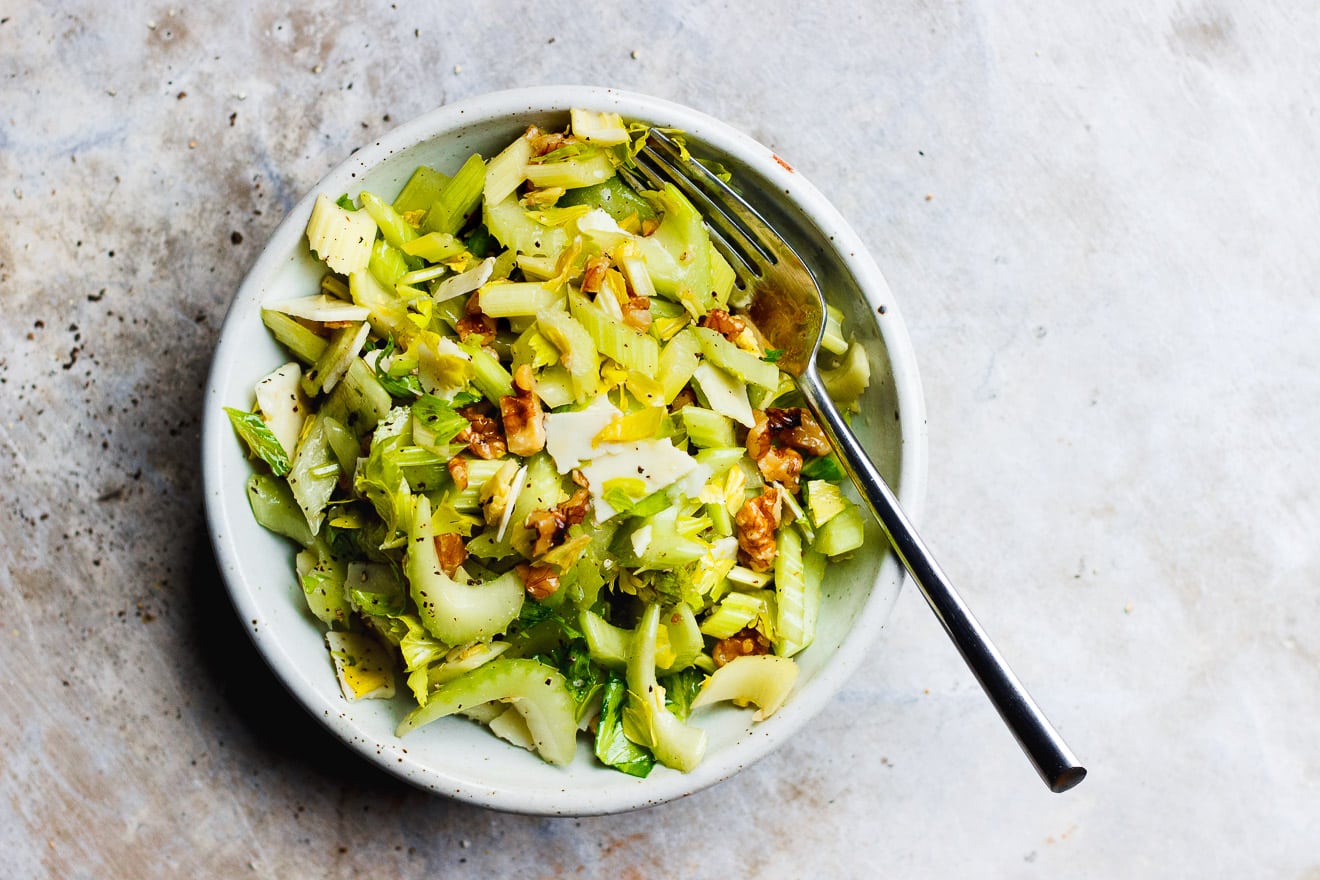On par with Ferrari, Gucci, and Prosecco, Parmigiano-Reggiano cheese is one of Italy’s most famous exports.
And yet it gets tangled up in the parmesan cheese category when really it’s a category all its own.
This semi-hard Italian cheese is beloved for its complex flavor ranging from salty and nutty to even fruity and spicy depending on its age.
But there is understandable confusion surrounding it. Say, if you’re wondering how to buy quality cheese, how parmesan is a paltry imposter, why Parmigiano-Reggiano is so expensive, and that it has surprising wellness benefits.
But before we get into all of that we dig into its 1,000-year history to help us understand how it has been crowned the “king of cheeses.”
A Brief History of Parmigiano
Parmigiano-Reggiano’s earliest beginnings trace back to the Middle Ages. In Northern Italy’s Emilia-Romagna region, Benedictine and Cistercian monks experimented with ways to preserve the milk they produced.
Italian monks are also credited in the region’s other famous food products’ origin stories including Prosciutto di Parma ham and Aceto Balsamico Tradizionale, by the way.
Earliest written evidence of the cheese’s existence goes back to a notary deed in Genoa around 1254 that alludes to “cheese from Parma.”
Moving forward Parmigiano-Reggiano’s popularity exploded in the 15th century thanks to n the Emilia region of the 15th century, feudal lords and abbeys contributed to the production increase of the Parma and Reggio plains that led to further economic development. In 1954 the 20th century the Consorzio del Formaggio Parmigiano Reggiano was formed. This protective organization works to promote the quality and tradition of this style of Italian cheese.
Later in 1992, the European Union (EU) recognized Parmigiano-Reggiano as a Protected Designation of Origin (PDO) product. The PDO label outlines a strict set of rules for how and where Parmigiano-Reggiano cheese is made. That includes specifics from the type of feed the cows that make milk for the cheese eats, to minimums on how long the cheese ages.

Ingredients In Parmigiano-Reggiano
As mentioned, making Parmigiano-Reggiano is a process with a capital “P.”
To begin, cheese makers use three natural ingredients: Cow’s Milk, salt, and rennet. Rennet is made up of enzymes that help solidify milk. But here’s where the Parmigiano-Reggiano making process gets nuanced.
According to the Italian law that governs PDO rules milk from which Parmigiano-Reggiano is made needs to come from Italian provinces of Parma, Reggio Emilia, Modena, the left side of the Reno river in Bologna, and the right side of the Po river in Mantua.
As such the cheese also needs to be produced in these areas. Plus the milk used needs to come from approved dairies that use four approved cow breeds, one of which is the rare vacche rosse or red cow breed.
To get even more specific, the three strains of bacteria needed to make Parmigiano-Reggiano cheese exist only in the hay from the Parma area, which the cows eat. And these three strains of bacteria help milk develop its distinct aromas and flavors.

How Parmigiano-Reggiano is Made
To produce the cheese, milk, rennet, and whey are combined and then left to curdle.
Half the milk comes from milking the night before and is skimmed, while the other half is the morning’s fresh milk—full fat.
Next they press the curd and mold it into wheels over the course of 2 to 3 days. Then they wash wheels in a salt bath (brine) every few days for about 20 to 25 days to remove fat and whey.
After, the whole wheels being the ageing process. The cheese is left to rest for one year minimum. Inspectors from the Consorzio del Formaggio Parmigiano Reggiano then do a quality check. If wheels pass they go back to aging before they’re sold.
If official Parmigiano-Reggiano cheese hopefuls show minor structural defects, they are downgraded to Mezzano (“medium grade”) and labeled as such. Spot Mezzano grade Parmigiano-Reggiano cheese by the parallel lines running down its rind.
While there is no max to how long the cheese can age, most wheels sold age for 2-3 years. If you see Parmigiano-Reggiano Stravecchio, that means the cheese has been aged (or “matured”) at least three years. It will have a granular texture that is highly prized.
During aging Parmigiano-Reggiano can develop crunchy, salty crystals known as tyrosine. This happens when certain proteins and amino acids break down.

What is the difference between Parmesan Cheese and Parmigiano-Reggiano?
If you’re new to Parmigiano-Reggiano, or the first thing you think of when you hear the term parmesan is the powdery condiment that comes in a slim green canister it’s important to know that parmesan is a totally different product.
At this time the U.S. only protects the term “Parmigiano Reggiano” and anything else is essentially imitation.
Meaning cheese made in the U.S. or South America for example (or anywhere outside of Europe) can be labeled Parmesan without having to go through the regulations outlined by the EU’s PDO label.
Parmigiano-Reggiano’s Health Benefits
Cheese may sound indulgent, but consuming Parmigiano-Reggiano in moderation packs an impressive nutritional punch beyond bone-strengthening calcium.
Without dizzying you with numbers, here’s how: One ounce of Parmigiano has daily values that add up to more protein than beef, more magnesium than salmon, nearly as much potassium as a banana and nearly as much vitamin A as carrots.
Not to mention it also boasts decent amounts of zinc, iron, and vitamin B6—micronutrients (vitamins and minerals) that help our bodies function at their best.
And, even though Parmigiano-Reggiano is a dairy product, it’s also lactose-free thanks to the bacteria in the cheese that eat the lactose.

How to Eat Parmigiano-Reggiano
There are many ways to eat Parmigiano-Reggiano and more often than not the simpler the better! Serve it with fresh and dried fruits, nuts, your favorite crunchy carbs, and Prosciutto di Parma as part of a charcuterie and cheese board.
Or turn to some of our favorite recipes. Grate it fresh over pasta or risotto, like our Classic Bolognese-Style Lasagna. Use flakes of it in this classic salad from Bologna. Then save the rind to give soups and stews an extra dose of umami.
For more info on how long parmigiano reggiano lasts and how to store it, check out these storage tips direct from the consortium.
Or, now that you’re fully prepped on all-things Parmigiano-Reggiano, travel with us on our next trip to Italy to taste it IRL.
Connect With Salt & Wind Travel
- Explore The Salt & Wind Travel Services
- Join Our Virtual Cooking Club
- Shop Our Store For Cooking And Travel Inspo
- Have Us Craft You A Custom Travel Itinerary
- Get Our Digital Travel Guides For Food Lovers
- Sign Up For Our Newsletter
More Italy On Salt & Wind Travel
- Prosecco To Lambrusco: All About Italian Sparkling Wine
- Stock Your Pantry With These Essential Italian Ingredients
- Must Know Tips For Eating In Italy
Photo Credit: red cow by makalex69; parmigiano production by Alessia Pierdomenico; cheese on racks By Minda photos; cut pieces By MikeDotta